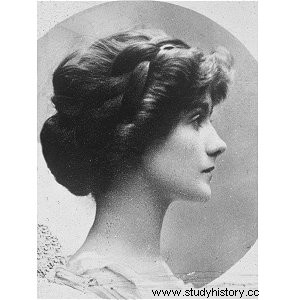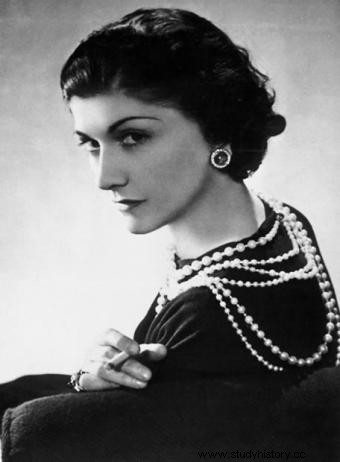Gabrielle Chanel known as "Coco Chanel" (1883 – 1971) was a French designer, creator of the famous Maison Chanel.
Coconut
 Daughter of Jeanne Devolle and Albert Chanel, Gabrielle was born on August 19, 1883 in Saumur, second of three sisters . His mother died of tuberculosis when she was twelve years old and his father abandoned his three daughters who ended up in the orphanage of the Cistercian abbey of Aubazine (Corrèze). She spent six austere years there before being entrusted to the ladies canonesses of the Institut Notre-Dame de Moulins who taught her sewing. In 1903, Gabrielle begins to work in a sewing workshop, but dreams more for her future.
Daughter of Jeanne Devolle and Albert Chanel, Gabrielle was born on August 19, 1883 in Saumur, second of three sisters . His mother died of tuberculosis when she was twelve years old and his father abandoned his three daughters who ended up in the orphanage of the Cistercian abbey of Aubazine (Corrèze). She spent six austere years there before being entrusted to the ladies canonesses of the Institut Notre-Dame de Moulins who taught her sewing. In 1903, Gabrielle begins to work in a sewing workshop, but dreams more for her future.
Around 1907-1908, during a trip to an uncle's house in Vichy, she began to sing in a café-concert, in front of officers. They are the ones who call her Coco, either because of a song she often performs, or because this nickname comes to her from her father. Highly admired and courted, she began an affair with Étienne Balsan, a wealthy officer with whom she discovered high society. After a few months, however, she ran off with one of Etienne's associates, businessman Arthur Capel, nicknamed "Boy".
Chanel Fashions
 In 1909, on the advice of Boy Capel, she started in Paris making original hats that she sells Boulevard Malesherbes. She also designs clothes. These creations were successful and Gabrielle quickly called on one of her sisters and a cousin to help her. Thanks to funds from Boy Capel, she opened a millinery salon in Paris under the name "Chanel Modes". A shop followed in Deauville in 1913 then a third in 1915 in Biarritz, which would become his first real workshop. She shortens the skirts, removes the waist, creates sports dresses, launches sailor tops and plays with feminine/masculine codes. One of the first to launch the fashion for short hair, she favors simplicity and practicality.
In 1909, on the advice of Boy Capel, she started in Paris making original hats that she sells Boulevard Malesherbes. She also designs clothes. These creations were successful and Gabrielle quickly called on one of her sisters and a cousin to help her. Thanks to funds from Boy Capel, she opened a millinery salon in Paris under the name "Chanel Modes". A shop followed in Deauville in 1913 then a third in 1915 in Biarritz, which would become his first real workshop. She shortens the skirts, removes the waist, creates sports dresses, launches sailor tops and plays with feminine/masculine codes. One of the first to launch the fashion for short hair, she favors simplicity and practicality.
The beginning of success
After the First World War, Coco Chanel gradually built a large fashion house employing more than 300 people, which enabled her to fully repay the funds advanced by Boy Capel. Her lover died in 1919 in a car accident, which affected her deeply and she took refuge in work. Over the following years, her success continued and she expanded her business, particularly in Paris. Very close to Misia Sert, hostess of the Parisian gratin, she frequented Toulouse-Lautrec, Odilon Redon, Auguste Renoir, Stéphane Mallarmé, Marcel Proust, Erik Satie, Colette, Picasso, Cocteau... In 1921, with the help of her perfumer Ernest Beaux , Coco Chanel launches a series of perfumes including the famous Chanel n°5, which is exported internationally. In 1924, she opened a jewelry workshop. In 1939, she was at the head of a company of 4,000 workers.
The Second World War
At the start of the Second World War, Coco Chanel closed her shop and laid off all her staff. She takes advantage of the rise of anti-Semitism to try to recover the Chanel N o perfume brand 5 whose rights belong in majority to a Jewish family, the Wertheimers. Between 1941 and 1944, she lived with Hans Günther von Dincklage, former German embassy attaché. Some claim that Coco Chanel would have been a spy for Nazi Germany, which she will always deny thereafter. At the Liberation, she was interrogated but immediately released on the intervention of Churchill. She then moved to Switzerland for ten years.
In 1954, aged 71, she returned to France at the insistence of the Wertheimers and reopened her house. She quickly returned to success, dressed the actresses of the moment (Romy Schneider, Jeanne Moreau) and saw her style copied all over the world.
On January 10, 1971, at the age of 87, Coco Chanel died of old age in her suite at the Hôtel Ritz in Paris.
Useful links
Coco Chanel's Wikipedia page
